New perk! Get after it with local recommendations just for you. Discover nearby events, routes out your door, and hidden gems when you sign up for the Local Running Drop.
No, it’s not the name of a new, ill-conceived Marvel Universe character. No, it’s not a recently discovered orangutan that’s the size of an elephant (thank goodness). It’s not a bird; it’s not a plane. It’s Supersapien, and it’s actually a very cool way to measure your blood glucose in real time and analyze it later through a bunch of different lenses. But is it worth inserting a tiny filament into your arm via a 4mm long hollow needle that communicates to the internet (the internet!) via Bluetooth and a smartphone? Read on to find out.
Supersapiens: What Is It? Really.
While we blast through the ups and downs of this super-advanced and slightly dystopian device in our upcoming quick review, and you can read more about the science behind constant blood glucose measurement here, here we’ll dig specifically into the nitty gritty of this device and platform.
RELATED: Understanding the Science Behind Blood Glucose Monitoring
First, Supersapiens is technically an app/platform that collects data from the Abbott Libre Sense device. It costs around $150/mo—depending on how many months you subscribe for. You’ll need two devices per month. The device itself is not yet FDA approved, though it’s expected to be very shortly. We’ll get into the mechanics of the Libre Sense further below in the device section, but the gist is that the Libre Sense detects the levels of glucose in your blood—in the same way a device would act for someone with diabetes. It stores the data in the device itself for up to eight hours and it also broadcasts the information, via Bluetooth, to an iOS or Android smartphone. The device itself has to be “placed” by the wearer (it doesn’t hurt…much), and you have to reinstall a new patch every 14 days.
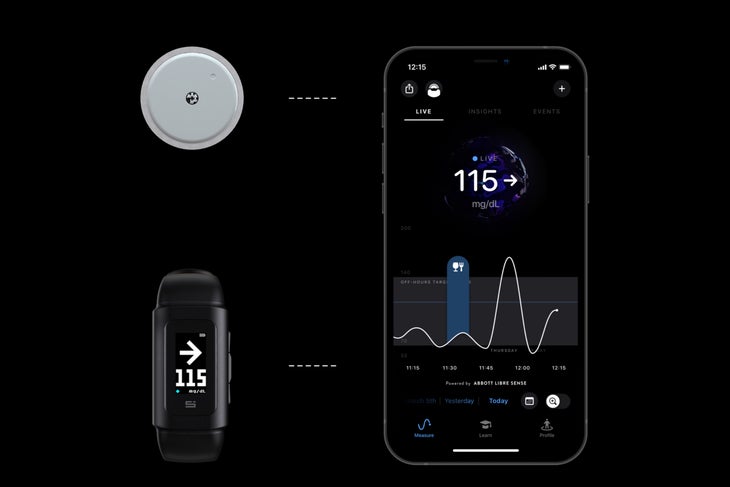
The Supersapiens app directly receives the Bluetooth blood glucose data (this is actually an important distinction we’ll get to later) and then begins to crunch the numbers and regurgitates the info into some very helpful charts, graphs, and indicators. The app also rebroadcasts the basic glucose levels to compatible Garmin devices (from the Forerunner 245 to the Fenix 6 series and some models in between; full list here).
Supersapiens: What is CGM? Why Do I Care About It?
Without digging into the science too much, glucose is one of the most important fueling sources that powers your body as you live and train. Of course, there are other fuel sources—fat for instance—but more people use glucose to power more of what they do than anything else. When it comes to training or racing, big drop in blood glucose levels can mean a dip in energy, which leads to a poor session or event. Low glucose levels can also impede recovery and even signal overall health issues. High blood glucose can be a good way to store up energy for a session or event, but heightened levels of blood glucose for long periods of time (or big spikes in blood glucose) can be damaging and also indicate health issues. People with diabetes need to monitor their blood glucose due to their body’s inability to manage their levels naturally, and sudden changes in blood glucose for diabetics can indicate problems and often need to be actively balanced via nutrition and exercise or with medication like insulin.
For endurance athletes like triathletes, maintaining even blood glucose levels, creating glucose stores, and simply monitoring blood glucose all add a dimension to the nutrition puzzle—particularly if you’re a long-course athlete. While it is a lot of work, even with something like Supersapiens, the hope is that a triathlete would learn enough about how their body, specifically, reacts to certain foods, training, hydration, and sleep/rest/recovery situations. Nutrition is often a dark art because everyone is different, and advice that works for one person might do the exact opposite for another.
In the past, nutritionists and physiologists have used more of a “spot-check” system for measuring blood glucose—either in the form of routine check ins and measurement or in short lab sessions. The beauty of continuous glucose monitoring (CGM)—and why it’s actually kind of a big deal—is that leaps in technology allow for non-diabetic people to monitor their blood glucose in a way that is non-invasive and (relatively) inexpensive, without the need for medical/insurance intervention and supplementation. Before devices like Abbott’s new line, CGM would only be appropriate—financially—for those who need to monitor their blood glucose in real time to prevent or control health issues. Now, CGM is accessible to those who want to either simply dial in their daily diet and live a better, healthier life (and lessen the risk of future health problems) or athletes who are looking to maximize training and get faster racing.
Supersapiens: The Device
As of this writing, Supersapiens can do quite a bit, but it can’t do a darn thing here in the U.S. Until the FDA clears Abbott’s Libre Sense, the Supersapiens platform doesn’t do anything at all. Check the Supersapiens website to see if it’s available in your country, but if you’re in the U.S., there’s a good chance the FDA will be approving the device shortly. If that pesky little pandemic didn’t block things up, the Libre Sense would likely have joined it’s less-sports-helpful, non-real-time cousin, the Freestyle Libre on the U.S. market, but patience is key here.
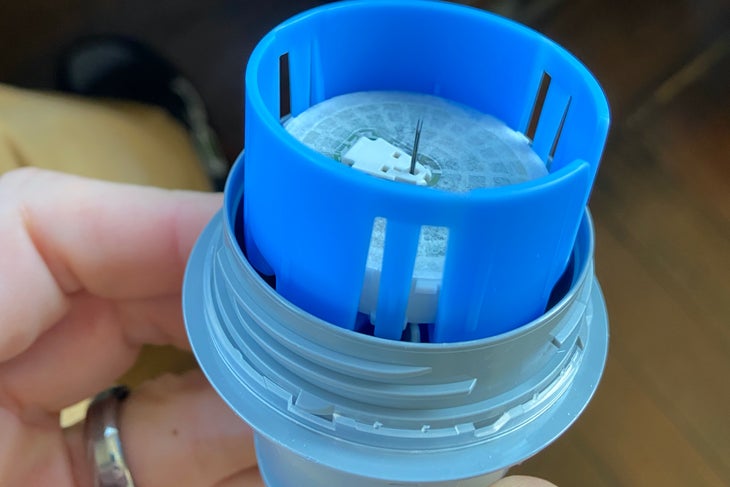
The final device is about the size and thickness of a quarter when it’s on your skin. It comes in a sterile box with an applicator that you self apply. To “install” the Libre Sense, you attach the device to the applicator in a very simple and impossible-to-screw-up process, press the applicator to your tricep area, and press down hard until you hear a very alarming click and feel a little pinch. That pinch is the 4mm hollow needle going into your arm, depositing a thin filament about the size and shape of a thick beard hair, and then retreating back into the applicator. You toss the applicator (needle now safely covered) and are left with that little white, plastic quarter thing stuck to your arm with a very strong clear cover sticker.
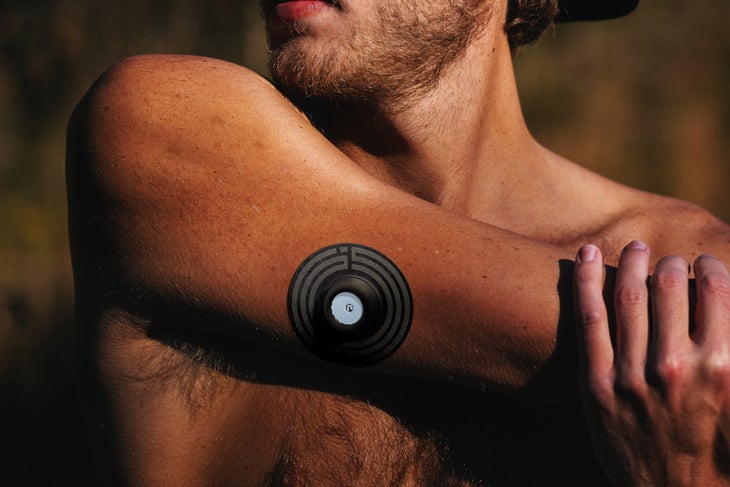
Supersapiens also has a “performance patch” that wasn’t included in the early testers, but the patch is meant to further secure the CGM monitor with a wider base of coverage. This is 100% crucial for triathletes who want to swim in a wetsuit or who think they’ll catch the device on clothing or doorways (trust me, you will). The device lives for 14 days, it’s waterproof, and we tested it successfully for at least 1.5 hours of swimming with and without a wetsuit with a patch similar to—but not exactly—Supersapiens’ performance patch.
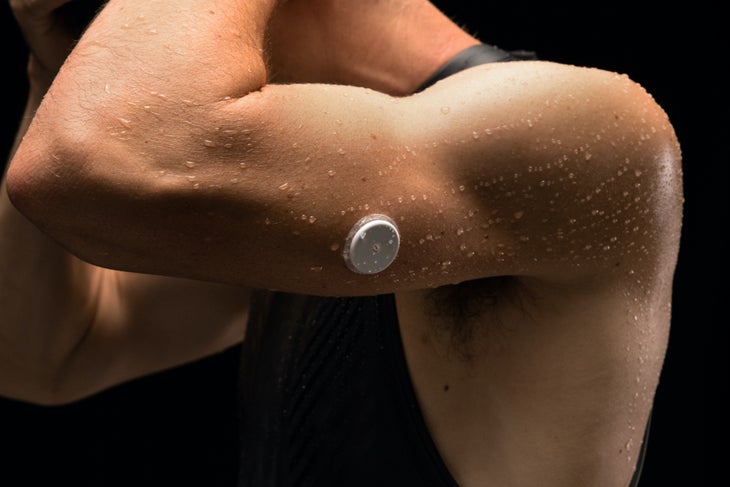
Once installed and paired with the Supersapiens app, the device takes about an hour to “warm up,” and then continuously broadcasts your blood glucose via Bluetooth while storing it for up to eight hours in case you’re out of range of your compatible smartphone. There are other devices that read and store glucose data to be transferred via near-field communication, but this is limiting as you cannot see your glucose levels or trends in real time—essential for training/raing situations. It’s also important to note that the “insights” that the app gives you (and we use that term very loosely) get better the longer you have the device on: The first day or two is not particularly revealing.
Supersapiens: What Can Supersapiens Do?
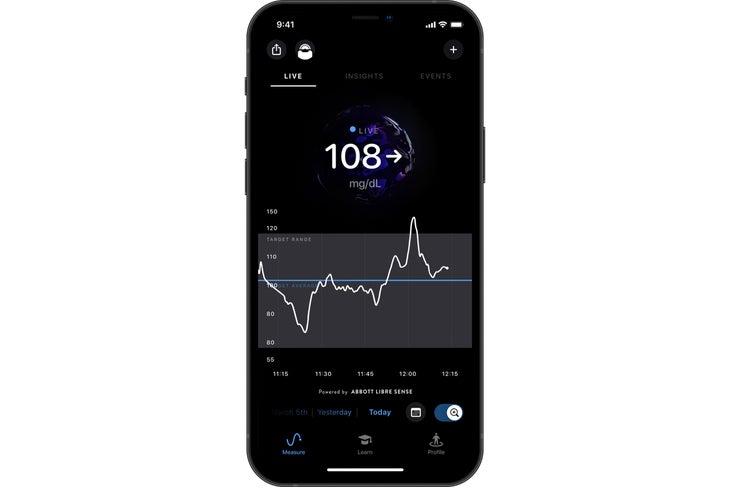
Once hooked up and after the initial warm-up, the Supersapiens app will allow you to look at your live blood glucose on either a Garmin device or on in the app itself. Currently, you can only see your live blood glucose values and a graphical trend line as a data field in a compatible Garmin with the app acting as a bridge. The Libre Sense device will not, as of this writing, broadcast directly to your Garmin, so you need to have the phone in Bluetooth range to see the data on your watch. You can also only see the data on your smartwatch while you’re in a training mode that has the data field installed—there’s no widget or watch face data field that lets you see it outside of a training session. More on this below.

The app itself, however, is extremely powerful and has a host of features to help you help yourself interpret your data. It displays your levels live above a zoomable graph where you can place and see various events that could impact your glucose levels. Adding events like training sessions, food, sleep, stress, and more is very easy, but it’s also absolutely essential in developing a picture of how what you do affects your blood glucose levels. If you don’t log everything diligently, it’s unlikely you’ll glean much from your data that you can apply into real takeaways. This may seem obvious, but the work involved is super important to think about when you’re considering the platform.
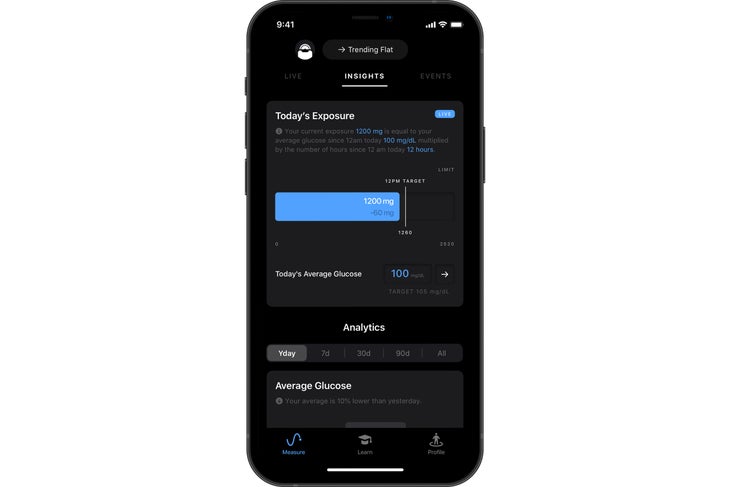
The Supersapiens platform also has an excellent “Insights” mode that gives you analysis like average glucose for the day (which also tells you your daily glucose exposure), glucose variability (for showing how wildly your glucose levels swing or don’t swing), and your glucose zones, which should feel very familiar to anyone who’s done training with heart-rate or power. All three major categories of analytics let you compare current values with historic values and try to lend some color and depth to your blood glucose picture.
Finally, the app also has an “Events” screen that compiles a list of the events you’ve either manually keyed in or have come in via Apple Health if you have iOS. The events will help you get a better sense of the cause and effect relationships between different types of training sessions, their timing, your recovery, your food intake, and so on. Again, without inputting your events very very thoroughly, you won’t take much away from the platform.

The app and Supersapiens’ website also have a fairly extensive learning platform to help users educate themselves on what everything means. This is important because unless you have a background in nutrition or medicine of some kind or you’re a very very avid nutritional hobbyist, the data, analytics, and even the “insights” won’t mean much to you at all. We’ll get to that in the next section, but you will need to take full advantage of the learning library if you’re actually going to get the platform to make you healthier or faster.
Supersapiens: What Can’t Supersapiens Do?
This is always a tricky question because most of the things we review obviously can’t fly or make you a sandwich (yet), but this is super important, especially when it comes to CGM, glucose levels, and nutrition for performance/health. Here, we won’t weigh in at all on the argument about whether or not monitoring blood glucose is the key to nutrition for triathletes. We’ll save that for another day, but know that there are those in the camp that say blood glucose will solve 90% of your nutritional issues in endurance training, and there are camps who say it’s only a very small piece of the puzzle.
Assuming analyzing your blood glucose levels daily and while you train/race is a very important thing, there is still a lot Supersapiens won’t do, but there are reasons way better than “this thing is garbage, and these people have no idea what they’re doing.”
First, while they use the term “insights” in the app, the Supersapiens platform will never tell you what to eat, what not to eat, how to train, etc. It’ll give you the learning and the tools to make those decisions yourself, but as of this writing, there is no level of personalization—either via an AI algorithm or a live consultant add-on—that will tell you what to do (or not to do). The biggest reason for this is that the Libre Sense is technically a medical device (hence the FDA stuff), and as such the company does not want to be held responsible for giving out anything that could be considered “medical advice.” The litigious nature of our society aside, refusing to give specific nutrition/training advice based on blood glucose levels is actually fairly smart. Unless you’re hiring a trained nutritionist who can meet with you and assess you, it would be dangerous to allow an algorithm to manage your glucose levels. Even the smartest AI or platform could easily dip someone into unhealthy eating, or much worse disordered eating. There are too many factors at play to place that level of responsibility in the hands of an app.
Supersapiens: The Experience
After weeks of using the Supersapiens platform, I found it to be incredibly resilient—both physically in terms of not coming off while training/living/sleeping, and technologically in terms of connections and data capturing. In the early testing I had small unexplainable gaps in data, but nothing that would truly affect my analysis. Also, the gaps became fewer and further between as I tested.
While having your blood glucose transmitted live via Bluetooth was far more convenient than having to retrieve stored data every few hours via NFC, this is still a platform and concept that requires extreme diligence. The events logging section of the platform is very easy to use, but it’s also a crucial and ever-present part of the experience. And while there are daily/weekly snapshots, they still require a fair amount of self-analysis based on your logging.
Even once you’ve mastered the art of logging events and built the habit into your daily living/training, you also need to be incredibly diligent when it comes to parsing out what event caused what reaction. Here, it’s important to take your own notes so you can try “experiments” and see what happens with your glucose levels and how your body reacts to different situations. In other words, a big part of the Supersapiens experience is really based in logging and attention to detail. The actual “installation” of the patch with the needle and the filament is very attention grabbing in terms optics, but that only slightly painful moment is a distant memory as you must carefully log and compare notes with your previous self.
Supersapiens: Takeaways
In an ideal world, you’d learn enough through excellent logging and note-taking that you’d be able to effectively “hack” your living/training and almost no longer even need the Supersapiens platform. You’d learn enough to change your routines, and you’d only need to check in on your glucose levels from time to time; the training wheels would come off, and you’d be able to ride on your own. And while the science isn’t even concrete on the importance of glucose levels in training/racing, the technology in this platform is pretty concrete. It does what it says it’ll do, but nothing more.
As I said earlier, you need to log basically everything you do if you’re to get actual, actionable insights that you can use to improve. If you miss lots of “events” consistently, you could be chasing false leads—like a detective who is missing crucial evidence in a crime. False leads can lead to faulty conclusions and frustration. Furthermore, expecting Supersapiens to give you the answers to your nutritional issues with no effort on your end is unrealistic, and unless you can use it in conjunction with a real-life expert, your best bet is to become an expert on yourself. While that may seem like a lot of work (and it is), being a self-expert is probably the best thing a triathlete can truly do to make themselves better.
